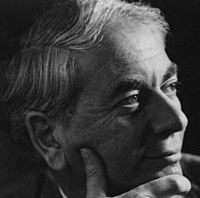Dennis W. Sciama facts for kids
Quick facts for kids
Dennis Sciama
|
|
|---|---|

Dennis William Siahou Sciama (1926–1999)
|
|
| Born |
Dennis William Siahou Sciama
18 November 1926 Manchester, Lancashire, UK
|
| Died | 18/19 December 1999 (aged 73) Oxford, UK
|
| Resting place | Oxfordshire |
| Nationality | British |
| Alma mater | Trinity College, Cambridge |
| Known for | Cosmology, black holes, Big Bang theory, darkmatter, gravitational waves, quasars. |
| Spouse(s) | Lidia Dina (1959–1999; his death) |
| Children | 2 |
| Awards |
|
| Scientific career | |
| Fields | Gravitation |
| Institutions | University of Oxford University of Cambridge Cornell University Harvard University King's College, London University of Texas at Austin Scuola Internazionale Superiore di Studi Avanzati Scuola Normale Superiore |
| Thesis | On the origin of inertia (1952) |
| Doctoral advisor | Paul Dirac |
| Doctoral students |
|
| Influenced | Roger Penrose |
Dennis William Siahou Sciama (born November 18, 1926 – died December 18/19, 1999) was a very important British physicist. He helped shape how physics developed in Britain after World War II. He was a PhD supervisor for many famous scientists, including Stephen Hawking. Many people see him as one of the main founders of modern cosmology, which is the study of the universe's origin and future.
Contents
Early Life and Learning
Dennis Sciama was born in Manchester, England. His family had roots in Syria.
He earned his PhD in 1953 from the University of Cambridge. His teacher was the famous physicist Paul Dirac. Sciama's research was about Mach's principle and inertia, which are ideas about how objects move and resist changes in motion.
Sciama's Work and Discoveries
Sciama taught at several universities, including Cornell University and Harvard University. He spent most of his career at the University of Cambridge and the University of Oxford. Later, he moved to Trieste, Italy, to teach astrophysics.
He connected many topics in astronomy and astrophysics. He studied radio astronomy and X-ray astronomy, which use different types of light to see space. He also researched quasars, which are very bright objects far away in the universe.
Sciama also studied the Cosmic microwave background, which is leftover radiation from the Big Bang. He looked into the space between stars and galaxies. He also explored dark matter, a mysterious substance that scientists believe makes up a large part of the universe.
His most important work was in general relativity, which is Albert Einstein's theory of gravity. He also studied black holes, which are areas in space where gravity is so strong that nothing, not even light, can escape. He helped bring back an older idea called Einstein-Cartan gravity.
From Steady State to Big Bang
Early in his career, Sciama supported the Steady state theory. This idea suggested that the universe has always looked the same and is always creating new matter. He worked with other scientists like Fred Hoyle on this theory.
However, in the 1960s, new evidence appeared, like the discovery of the Cosmic microwave background. This evidence strongly supported the Big Bang theory, which says the universe started from a very hot, dense point and has been expanding ever since. Sciama was one of the few scientists who changed his mind and accepted the Big Bang theory.
In his later years, Sciama became very interested in dark matter. He explored ideas about what dark matter might be made of, like a type of heavy neutrino.
Inspiring Future Scientists
Dennis Sciama was a PhD supervisor to many students who became leading scientists in astrophysics and cosmology. Some of his famous students include:
- George Ellis (1964)
- Stephen Hawking (1966)
- Brandon Carter (1967)
- Martin Rees (1967)
- Gary Gibbons (1973)
- James Binney (1975)
- John D. Barrow (1977)
- Philip Candelas (1977)
- David Deutsch (1978)
- Adrian Melott (1981)
- Antony Valentini (1992)
He also greatly influenced Roger Penrose, another famous mathematician and physicist. The group of students he led in Cambridge in the 1960s had a lasting impact on the study of the universe.
Awards and Recognition
Sciama was elected a Fellow of the Royal Society (FRS) in 1983. This is a very high honor for scientists in the UK. He was also an honorary member of other important scientific groups. He led the International Society of General Relativity and Gravitation from 1980 to 1984.
To honor his contributions, a special lecture series was created in his name: the Dennis Sciama Memorial Lectures. In 2009, the Institute of Cosmology and Gravitation at the University of Portsmouth named their new building after him. They also named their supercomputer after him in 2011.
Sciama has been shown in movies about his most famous student, Stephen Hawking. In the 2004 BBC TV movie Hawking, he was played by John Sessions. In the 2014 film The Theory of Everything, he was played by David Thewlis.
Personal Life
Dennis Sciama was of Jewish-Syrian background. He was married to Lidia Dina, a social anthropologist, and they had two daughters.
See also
 In Spanish: Dennis Sciama para niños
In Spanish: Dennis Sciama para niños

